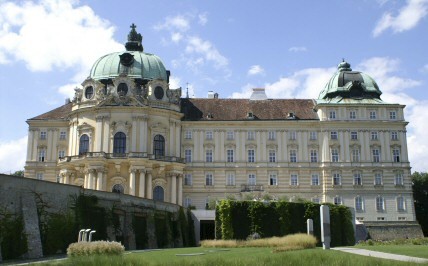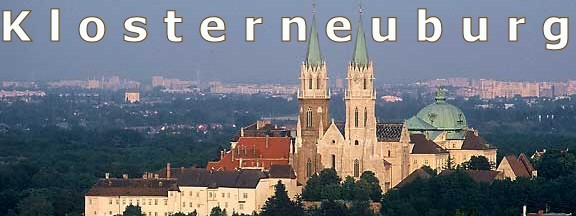Margrave Leopold of Austria and his wife Agnes stood in 1106 on the eighth day after their wedding on the Söller of their castle on the Leopoldsberg (at that time still called Kahlenberg) and looked down on Vienna (which at that time was only a small, insignificant settlement within the old Roman city walls). They discussed the foundation of a monastery and were only undecided about the place where it was to be built. All of a sudden a gust of wind rose and Agnes tore the veil off his head and carried it away. The young margravine was very shocked by this precious loss. Leopold hurried with his entourage into the forest where the wind had carried the veil, but they could not find it. Eventually he was forgotten, as was the founding of the monastery discussed then, although the margrave had promised his wife to found a monastery where the veil could be found. Eight years had passed when Leopold once again hunted in the forest. Then the dogs struck loudly all of a sudden, and when the margrave came along, he found the veil hanging on an elder bush; a miracle had kept it intact all these years. This prompted the margrave to immediately fulfill his vow. According to legend, the monastery of Klosterneuburg was built on this site.
So much for the veil legend. During my pilgrimage from Leipzig to Constance I came across an amazingly similar veil legend in Frauenroth (stage: Kreuzberg- Schweinfurt).
You can find out how the monastery actually came into being under the link "Foundation history". How Margrave Leopold III became a saint under "Canonization". His wife Agnes also deserves to be considered beyond the veil legend. The longer I have dealt with her, the more she became an interesting power woman in the background of Leopold III. Read more about Agnes and her many children.

Today's church has been through a lot over the centuries. The original Romanesque basilica (only preserved in the choir area) underwent Gothic and late Gothic alterations after a monastery fire (1330) (west façade until 1592). Then there was a gradual Baroqueization, an early Baroque coinage (1634-45) by transformation of the side aisles into chapels, as well as the installation of the west gallery and stucco decoration and a high Baroque fresco decoration by J. M. Rottmayr and stucco by S. Bussi (1680-1723). The presbytery was also baroqueised between 1723 and 1730. In an extensive restoration of the exterior in the 19th century under F. von Schmidt, the west towers were supplemented in neo-Gothic style. During a further facade restoration around 2000, the original colours of the original grey towers were uncovered. They are different because different materials were used.
The monastery houses the "Verdun Altar", a wonderful work of art from the Middle Ages (1181). It is named after his artist Nikolaus von Verdun.
The 51 enamel panels are arranged in three horizontal zones which correspond to the epochs of salvation history. The upper zone represents the time "before the law" (ante legem, before Moses), the lower zone the time "under the law" (sub lege, between Moses and Christ) and the middle zone the time "under grace" (sub gratia, the Christian age).

From 1730 the most gigantic of all baroque monasteries was to be built in Klosterneuburg. According to the will of Emperor Charles VI, the monastery and imperial palace were to form a single unit - modelled on the Escorial near Madrid. When the ambitious project was discontinued ten years later after the death of Charles VI, only a little more than one eighth of the building project had been completed. Today there is only one of the four courtyards planned. Only two instead of the planned nine domes could be realized. However, they bear the two most important crowns: the Roman imperial crown and the Austrian archduke's hat.




Danube cycle route

Looking for Gertrud:
Here was the seat of her second husband, Henry II, Jasomirgott, son of Leopold III, as Margrave of Austria. Gertrud died on her birthday on 18.4.1143, about one year after her wedding.
Henry II was Duke of Bavaria (and Margrave of Austria) and his wife Gertrud was in charge as Duchess of Saxony
for their minor son from her first marriage, Henry the Lion. She was very pregnant when she said goodbye to her
former home and to her son in Braunschweig in order to travel to Bavaria. In doing so, she had probably exposed herself
to efforts which led to a premature birth. It comes to a catastrophe. She dies of the consequences of the difficult
birth of her daughter Richardis. Her husband, in whose company she presumably was, had her body buried in the
monastery Klosterneuburg near Vienna founded by his father.
We would have found Gertrud's last resting place if there hadn't been Frederick II, the belligerent, the last Babenberger.
In the 13th century Frederick II transferred her to the burial place he had created for the Babenberg family. We are close, but here in Klosterneuburg she can no longer be found. The search continues. So she lies in the burial place of the Babenbergs and that is certainly in Austria, but where?
By the way: Henry II Jasomirgott married a second time and moved the seat of government from Klosterneuburg to Vienna in 1155.